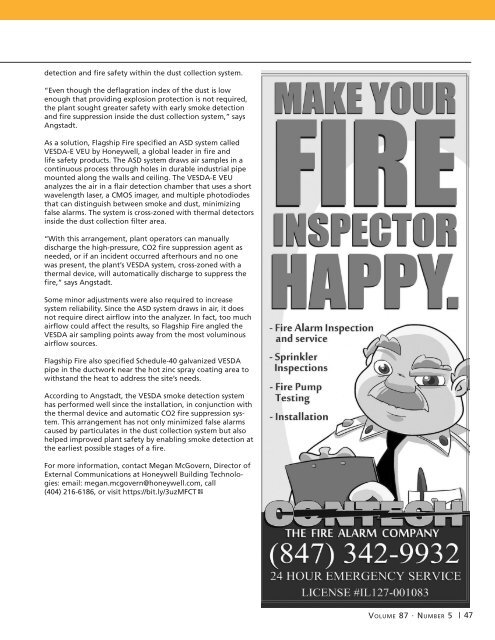CEAC-2022-05-May
You also want an ePaper? Increase the reach of your titles
YUMPU automatically turns print PDFs into web optimized ePapers that Google loves.
detection and fire safety within the dust collection system.<br />
“Even though the deflagration index of the dust is low<br />
enough that providing explosion protection is not required,<br />
the plant sought greater safety with early smoke detection<br />
and fire suppression inside the dust collection system,” says<br />
Angstadt.<br />
As a solution, Flagship Fire specified an ASD system called<br />
VESDA-E VEU by Honeywell, a global leader in fire and<br />
life safety products. The ASD system draws air samples in a<br />
continuous process through holes in durable industrial pipe<br />
mounted along the walls and ceiling. The VESDA-E VEU<br />
analyzes the air in a flair detection chamber that uses a short<br />
wavelength laser, a CMOS imager, and multiple photodiodes<br />
that can distinguish between smoke and dust, minimizing<br />
false alarms. The system is cross-zoned with thermal detectors<br />
inside the dust collection filter area.<br />
“With this arrangement, plant operators can manually<br />
discharge the high-pressure, CO2 fire suppression agent as<br />
needed, or if an incident occurred afterhours and no one<br />
was present, the plant’s VESDA system, cross-zoned with a<br />
thermal device, will automatically discharge to suppress the<br />
fire,” says Angstadt.<br />
Some minor adjustments were also required to increase<br />
system reliability. Since the ASD system draws in air, it does<br />
not require direct airflow into the analyzer. In fact, too much<br />
airflow could affect the results, so Flagship Fire angled the<br />
VESDA air sampling points away from the most voluminous<br />
airflow sources.<br />
Flagship Fire also specified Schedule-40 galvanized VESDA<br />
pipe in the ductwork near the hot zinc spray coating area to<br />
withstand the heat to address the site’s needs.<br />
According to Angstadt, the VESDA smoke detection system<br />
has performed well since the installation, in conjunction with<br />
the thermal device and automatic CO2 fire suppression system.<br />
This arrangement has not only minimized false alarms<br />
caused by particulates in the dust collection system but also<br />
helped improved plant safety by enabling smoke detection at<br />
the earliest possible stages of a fire.<br />
For more information, contact Megan McGovern, Director of<br />
External Communications at Honeywell Building Technologies:<br />
email: megan.mcgovern@honeywell.com, call<br />
(404) 216-6186, or visit https://bit.ly/3uzMFCT<br />
Volume 87 · Number 5 | 47


















